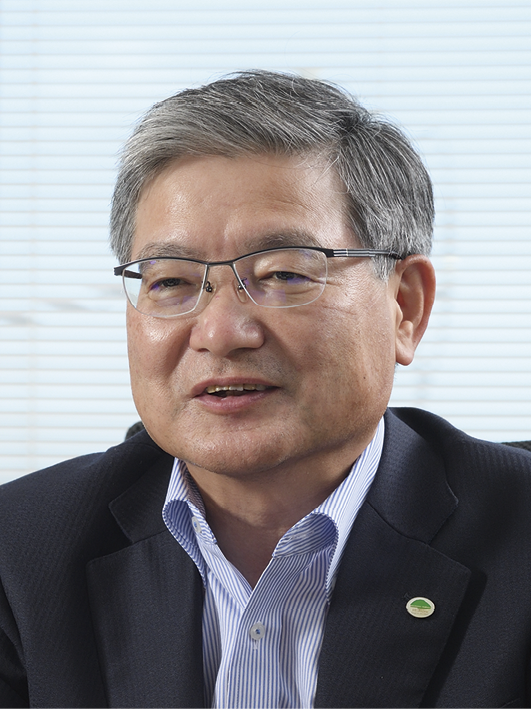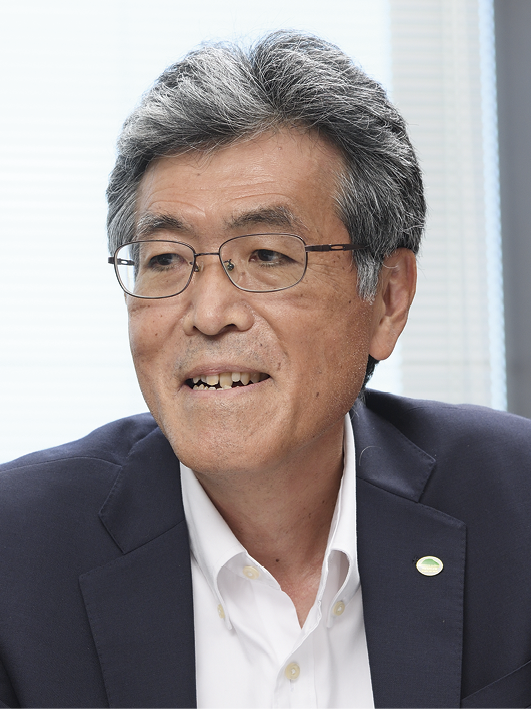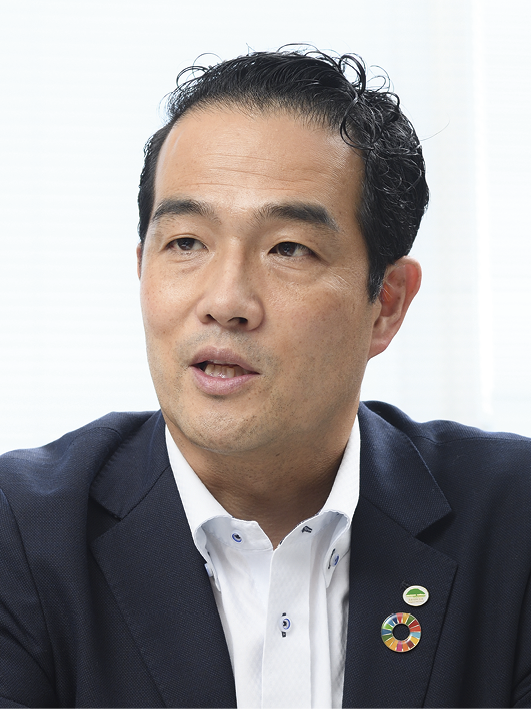COVER STORY:ACTIVITIESCreation of New Value for Future MobilityHitachi’s Technology Strategy for Achieving Sustainable Mobility
Highlight
Amidst accelerating innovation in the technological areas referred to as “CASE,” Hitachi has established a new group structure as it develops many solutions that make use of advanced and sustainable mobility technology. These initiatives are being undertaken with the aim of delivering social value to enhance QoL in a digital society, environmental value to help resolve the challenges facing the global environment, and economic value for customers. Moreover, this creation of new value is playing a clear role in the achievement of sustainable mobility. Here, Hitachi Review speaks to five key people about the technology strategies for achieving this, current progress on development, and their vision for the future.

Promoting Sustainable Mobility for a CASE Era
 Kimiya Yamaashi
Kimiya Yamaashi
Deputy CTO of Hitachi Astemo, Ltd.
The automotive world is embarking on a period of major change in what has been called a once-in-a-hundred-years transition. With new market entrants such as IT companies joining the industry alongside the existing vehicle manufacturers and their suppliers, a key term characterizing the areas in which this change is happening is “CASE,” an acronym of “connected,” “autonomous,” “service & shared,” and “electric.” Prompted by these developments, the European Commission, a branch of the European Union (EU), laid out a new policy in 2021 whereby it intends to ban the sale of new gasoline-powered vehicles (including hybrids) within its borders from 2035.
Meanwhile, Hitachi Astemo, Ltd. was established as a new company in January 2021 through the merger of Hitachi Automotive Systems, Ltd., Keihin Corporation, Showa Corporation, and Nissin Kogyo Co., Ltd. Along with its powertrain and chassis business for four-wheeled vehicles, the operations of the new company also extend to motorcycles. Kimiya Yamaashi, Deputy CTO of Hitachi Astemo, describes the current situation.
“This merger strengthens our company’s position as one of the few suppliers worldwide that can combine technologies for driving, cornering, and stopping as well as the ride comfort provided by suspension. Along with updating our product and business roadmap by consolidating our products in each of these categories and through the pursuit of synergies, we are also developing a new technology roadmap that combines the high levels of technical expertise from each of the merged companies.”
Figure 1 | Hitachi’s Vision for Mobility
The objective is to deliver environmental value by taking advantage of Hitachi’s extensive capabilities to reduce emissions through efficient electrification technologies, and social value in the forms of safety, comfort, and enhanced quality of life (QoL) through advanced chassis technologies together with autonomous driving and advanced driver assistance systems (AD/ADAS).
The “Astemo” in the company name stands for “advanced sustainable technology for mobility,” with “sustainable” referring to not only environmental value, but also the sustainability of human life. Numerous customers and other business partners have provided feedback on how they hope this new corporate structure will impact the industry [1].
[1] Interest in Hitachi Astemo Products and Solutions![[1] Interest in Hitachi Astemo Products and Solutions](/rev/archive/2022/r2022_01/activities/image/tbl_01.png) The charts above were compiled from the results of surveying customer interest in key Hitachi Astemo, Ltd. products with strong growth prospects (powertrain, AD/ADAS, chassis, motorcycle, and software and connectivity products)*. In terms of the overall trend, the survey found considerable interest in areas that go beyond the supply of specific products. These include software and other technologies for integrated vehicle control, technological and business model innovation, and the establishment of data platforms. This indicates a need to pursue synergies between the new Hitachi Astemo corporate structure and the wider Hitachi Group.
The charts above were compiled from the results of surveying customer interest in key Hitachi Astemo, Ltd. products with strong growth prospects (powertrain, AD/ADAS, chassis, motorcycle, and software and connectivity products)*. In terms of the overall trend, the survey found considerable interest in areas that go beyond the supply of specific products. These include software and other technologies for integrated vehicle control, technological and business model innovation, and the establishment of data platforms. This indicates a need to pursue synergies between the new Hitachi Astemo corporate structure and the wider Hitachi Group.
Drawing on Power of Technology to Overcome Challenges Facing EVs on Road to Carbon Neutrality
 Toshiharu Nogi
Toshiharu Nogi
General Manager, Advanced Mobility Development Unit, Technology Development Functional Division, Hitachi Astemo, Ltd.
 Shiro Yamaoka
Shiro Yamaoka
General Manager, the Center for Technology Innovation – Electrification, Research & Development Group, Hitachi, Ltd.
 Shuichiro Miura
Shuichiro Miura
General Manager, Connected Car Division, Smart Digital Solution Business Development Division, Smart Life Business Management Division, Hitachi, Ltd.
So, what specific actions are being taken to achieve sustainable mobility? Toshiharu Nogi, General Manager of Advanced Mobility Development Unit, Technology Development Functional Division, Hitachi Astemo, Ltd., comments as follows on the increasing pace of vehicle electrification in pursuit of carbon-free and carbon-neural objectives.
“Electric motors are one critical component, and this is a field where Hitachi has more than 100 years of experience and accumulated expertise going back to the 5-hp motor that was the company’s first-ever product. As we also have more than 50 years of product experience with automotive electric motors and inverters since the 1970s and electrification represents a major opportunity for us. Key factors are high output density to reduce the size and weight, and scalability. For high output density, we are drawing on Hitachi’s accumulated expertise in electromagnets, structural design, vibration analysis, and simulation to achieve development efficiency. We are also utilizing model-based design technology to optimize small and lightweight e-Axle powertrains that combine an electric motor, inverter, and gearbox. Another strength of Hitachi is how we were able to make a smaller and lighter e-Axle by developing proprietary technology for double-sided cooling of the inverter.”
Shiro Yamaoka, General Manager, the Center for Technology Innovation – Electrification, Research & Development Group, Hitachi, Ltd., adds further detail.
“In terms of scalability, Hitachi is continuing to undertake research and development (R&D) into the key factors influencing competitiveness in motor inverter development, namely miniaturization and loss reduction, also using things like power module technologies with low switching losses that allow for double-sided cooling. The Research & Development Group, meanwhile, is looking further ahead as it seeks to address societal challenges, developing technology for grid interconnection that considers how to reduce the load on the environment and how to go about using and redistributing electric power.”
Shuichiro Miura, General Manager, Connected Car Division, Smart Digital Solution Business Development Division, Smart Life Business Management Division, Hitachi, Ltd., provides the following explanation of the work being done on e-mobility operator services, meaning services that encourage the wider adoption of electric vehicles (EVs).
“We are looking at offering services that address the difficulties that logistics businesses and other mobility operators face when shifting to EVs, and in terms of technology we are pushing ahead with the provision of three such solutions. The first solution relates to batteries and seeks to overcome these problems through battery lifecycle management, encompassing the monitoring of batteries, assessing their remaining life, and redeploying them for stationary power storage. Maintenance is another important consideration. As EVs are different from internal combustion engine (ICE) vehicles in that they can be put out of service by traffic accidents, we offer maintenance services based on EV availability. Finally, we are looking at providing services aimed at overcoming the limitations of vehicle range, such as tracking vehicle movements and advising on better routes.”
Combining “Look-ahead” with Coordinated and Integrated Control to Make Mobility Safe and Stress-free
 Yosuke Sekino
Yosuke Sekino
General Manager, Global Engineering, Chassis Division, Hitachi Astemo, Ltd.
Along with work on the environmental value of electrification, safe and stress-free mobility facilitates the provision of social value that is the underpinning of sustainable mobility. On this topic, Yosuke Sekino, General Manager of Global Engineering, Chassis Division, Hitachi Astemo, Ltd., has the following to say.
“In the field of chassis systems, one of the flagship new technologies for enhancing safety and QoL is that of ‘by-wire’ control. In the case of suspension, this refers to the use of linear motors for active suspension. Precision dampers capable of instantaneous control can make driving on even undulating or corrugated road surfaces feel like riding on a flying-carpet. Looking ahead to future advances in autonomous driving, this is a technology that can make trips by vehicle more comfortable. On brake-by-wire, we are researching the adoption of full electronic control for the electric motor and mechanical brakes on each of the four wheels. By providing precision control with no hydraulic circuit, this offers more efficient dynamics and greater freedom to coordinate and integrate control with other devices. For steering-by-wire, a technique is being developed that applies small steering movements to the tires to make automatic corrections without any driver steering input. We are also working on experimental initiatives intended to make driving easier for the elderly or disabled, such as use of dials, joysticks, or other simpler, less physically demanding controls to drive the vehicle, for example.” Hitachi has a long history of R&D encompassing not only driving systems like these, but also sensing and situation assessment techniques.
Toshiharu Nogi adds, “Stereo cameras that use dual cameras to acquire both images and three-dimensional (3D) information have been deployed as core sensors in driver assistance applications since 2008. This 3D view of the world is obtained by using parallax (the difference between the images from the left and right cameras) to calculate the distance to objects. Key features of this technology are that it can detect objects with shapes or color patterns that have not previously been catalogued, and that it can detect and range objects even if they are not fully visible. As this takes much less time than using machine learning to recognize objects, it can avoid collision very quickly in situations such as when another car pulls out in front of the vehicle, even before it is fully visible. Augmented with artificial intelligence (AI) or advanced processors, the technology should be able to identify even more complex situations in the future.
Meanwhile, in anticipation of the operational design domain (ODD) for autonomous driving expanding beyond highways to include local roads, we are also developing risk prediction mapping as a means of predicting and taking action to avoid potential risks outside the vehicle’s field of view. We hope that the use of this ‘look-ahead’ technology will allow for decision-making at a similar level to a human being.”
Recent years have seen a heightened focus on coordinated and integrated control as a means of enhancing QoL by maintaining safety in autonomous driving mode or by making vehicles fun to drive when autonomous driving is not engaged.
Yosuke Sekino put it like this: “AD/ADAS as it currently stands performs vehicle control in what you might call the ‘linear range,’ with numerous problems still remaining for its application in non-linear situations where control is more difficult. To address this, our philosophy is to coordinate and integrate the control-by-wire techniques discussed earlier so that control of the vehicle can be adjusted as needed to suit a variety of different situations, handing control to whichever device is best suited to the particular circumstances. Specifically, vehicle performance, including control in non-liner situations, can be further enhanced by the coordinated and integrated control of driving, braking, and steering as well as by raising or lowering the suspension for attitude control.”
Hitachi Astemo is also working on the safety and security of mobility from the perspective of services.
As Shuichiro Miura comments, “Hitachi is looking at this in terms of both AD/ADAS and full autonomous driving. It is vital that AD/ADAS be affordable, which is to say practical. One current practice is the use of high-definition (HD) maps to further narrow-down vehicle position. However, the high cost of these HD maps and the very limited number of roads for which they are currently available means that a lot of money will need to be spent before they can be used for autonomous driving away from main highways. Instead, we are looking to develop and supply detailed geometry maps (DGMs) that utilize satnav maps and information collected from vehicles to provide the information for real-world sensing and situation assessment at a level equivalent to HD maps.
As for fully autonomous driving, we are looking to deploy this in confined areas such as waterfronts, industrial sites, or mines. Traffic management systems are a strength of Hitachi. By utilizing these to automate the movement of goods in such locations, we believe we can also help to overcome the societal problems associated with the driver shortage.”
Shiro Yamaoka adds that, “We also see scope for utilizing concepts from railway signaling and traffic management systems in the practical implementation of autonomous vehicles and other forms of automation, especially in relation to the real-world interactions between machines and people that this entails. In practice, this would work by restricting where machinery is able to operate under automatic control, taking account of human safety and adjusting this region dynamically based on factors such as what people are doing, how the machinery is being controlled, and the operating conditions. Any machine that violates the restrictions would be halted and switched from automatic back to manual control. To begin with, we are looking to deploy autonomous driving in restricted areas. We are developing techniques for ensuring safety that incorporate sensing and other technologies into this dynamic region of automatic control and that can shutdown equipment in an instant to prevent people and machines from getting in each other’s way. The idea is to gradually expand the scope of these systems to cover autonomous driving on local roads.”
Imagining Future Vehicles Best Suited to Ongoing Digitalization
At the same time as vehicles are evolving into a form of mobility that is safe and carbon-free, those vehicles are also undergoing rapid digitalization. What developments and strategies are Hitachi Astemo deploying in response to these changes?
Toshiharu Nogi responds, “Onboard computers are linked by fast gigabit networks, enabling cross-domain control that integrates the powertrain, AD/ADAS, and chassis systems. One example might be to improve fuel economy by having the powertrain make use of sensing information on the movements of the vehicle ahead acquired for use in collision prevention or automatic following. A major strength for Hitachi when it comes to cross-domain control is that we have a full range of products for making vehicles go, turn, and stop.”
Shuichiro Miura adds, “The ongoing digitalization of vehicles means that we need to be aware of risks such as cyberattacks. We are seeking to supply security services to vehicle manufacturers in line with changing regulatory requirements. Hitachi has experience with network monitoring and security operation centers and we are putting together solutions with functions capable of reliably monitoring vehicles just like any other device. In the case of the DGMs we talked about earlier, we update these using data from the market and other sources. Along with more accurate prediction, we are also developing specific technologies such as autonomous driving experience databases (ADDs) that work by collecting crowd-sourced information and distributing it via connected car networks for use by other vehicles. The need at particular times of the day to change freeway lanes early to avoid missing an exit is one example of such information. From comparatively simple applications like this, information from sources other than vehicles gets collected in Lumada and we intend to look at making use of this information to establish new businesses in the future.”
Hitachi Astemo is also working to deploy digital technology in its chassis systems, an application that at first glance appears to have little to do with digitalization.
As Yosuke Sekino puts it, “Coordinated and integrated control can be used in both offensive and defensive ways. For example, while it may be necessary for reasons of safety or security to install a second or third backup unit for specific devices to provide redundancy in the power supply, sensor, or control unit systems, this acts against the goal of affordability and so we are looking at ways around this that are based on complementarity. The requirement is that an alternative device be available to take over in the event of a device failure, thereby reducing the need for double or triple redundancy. We are just getting started on this defensive use of control.”
Development of Virtual Testing Practices to Augment Real-world Testing on Demo Vehicles
In recent years, Hitachi Astemo has been taking steps to meet the demand from vehicle manufacturers for the supply not only of individual parts, but also of systems, including conformance aspects.
Kimiya Yamaashi comments, “We want to supply more efficient and effective systems by taking the parts we have and combining them into systems or sub-systems. To be able to offer complete systems, however, we also need to be able to configure and test them. To this end, we conduct real-world testing whereby we have built a demo vehicle that customers can drive for themselves and provide feedback.”
Autonomous driving needs to be tested under a wide range of scenarios, a requirement that calls for creative measures.
Toshiharu Nogi explains, “It is said that 10 billion kilometers of driving is needed to verify the safety of autonomous driving. Expanding the ODD beyond highways and out into local roads involves conducting a variety of safety tests under different combinations of conditions that include things like road conditions, traffic rules, lane markings, obstacles, daytime, glare, and rain. We have been able to reduce the testing workload considerably by combining computer graphics with hardware in the loop simulation (CG HILS). Used in the development of stereo cameras, this technology is also suited to the testing of autonomous driving, using high-resolution CG images of the external view from the vehicle as input to the actual vehicle cameras. For more complex environments, we have also participated in the Strategic Innovation Promotion Program (SIP) project to establish simulation environments that replicate the real world with a high level of fidelity by using virtual modeling of physical phenomena based on the principles of sensor detection.”
Global Deployment of Initiatives in Response to Local Requirements
 Alexander Kleinmann
Alexander Kleinmann
Head of Engineering Center Europe, Hitachi Astemo Europe GmbH
 John Nunneley
John Nunneley
Senior Vice President, Hitachi Astemo Americas, Inc.
Looking beyond Japan, different regions such as Europe, North America, and Asia require different forms of mobility. In the case of motorcycles, for example, whereas leisure applications predominate in Europe with an emphasis on the riding experience, electrification is making progress in India and other parts of Asia where motorcycles are mainly used for commuting. Given this backdrop, what strategies is Hitachi Astemo adopting for its global operations?
Alexander Kleinmann, Vice President at Hitachi Astemo Europe GmbH, comments as follows on what Hitachi is doing in Europe.
“While environmental regulations have been strengthened against the backdrop of the European ambition to become climate neutral (European Green Deal), Hitachi Astemo Europe has accelerated its R&D activities to realize a zero-impact emission powertrain. Besides the uptake of electrification, ICE is still expected to remain a key technology for various vehicle applications in the mid-term future. Therefore, we are developing a combustion system that matches perfectly with scalable hybrid electric powertrain architectures and will be compatible with all future relevant carbon-neutral fuels on the European market. Due to our collaboration with European universities, technical research institutes, and the industrial world, we are well prepared for the next generation of cutting-edge powertrain technology. As a result of our intensive cooperation with the Japanese development team, we started several mass production projects for inverters for electric vehicles, and at the vehicle level we are expanding the use of Lumada as an interface for ADAS technology.”
Figure 3 | Powertrain Technology Development in Europe
Likewise, John Nunneley, Senior Vice President at Hitachi Astemo Americas, Inc., has the following to say about what is happening in North America.
“Hitachi Astemo Americas, Inc. is always looking for collaboration opportunities with customers and partners and currently has several active collaboration activities in the AD/ADAS space. The first project is with TomTom International B.V., the location technology specialists. Through the collaboration, Hitachi Astemo Americas will combine technological strengths to deliver real-time updates on the location of road hazards, detected by Hitachi Astemo’s vehicle sensors, electronic control unit (ECU), and on-board deep neural network (DNN), to navigation and ADAS applications running TomTom’s connected services. The second project is similar in nature and will be conducted with the company’s partner L3Harris Technologies, Inc. The company will conduct a proof of concept (PoC) to develop an in-vehicle global weather intelligence solution. And finally, I would like to mention a recently announced collaboration with Light Labs Inc. Hitachi Astemo Americas began field testing a new multi-view, camera-based sensing technology in July 2021. Light’s Clarity* systems have better range, detail, and accuracy at a distance than existing sensor solutions and integrate seamlessly into Hitachi Astemo’s ADAS to work directly with other ADAS and ECU applications.”
- *
- Clarity is a registered trademark of Light Labs Inc.
How to Transform Mobility and Society for Good on Basis of Connected Cars
As part of the wider Hitachi Group, Hitachi Astemo is working toward the 2030 goals of carbon neutrality in its factories and offices and a halving of carbon dioxide (CO2) emissions from the use of its products. How then do they see the future beyond 2030?
Kimiya Yamaashi answers, “Alongside the inevitable growth in demand for decarbonization and safety, we also anticipate greater interoperation between vehicles and other systems as we move toward the super smart society. This will involve the creation of new value that links all people and things together and merges the cyber and physical realms. At Hitachi, I expect that we will also continue working together across the group on things like Lumada services, mobility-as-a-service (MaaS), and society-wide energy management. As well as engaging in collaborative creation with customers from a wide range of fields and industries on interoperation with power grids or on the task of putting services in place, I also expect to see an expansion in the establishment of consortia.”
Shuichiro Miura comments, “Currently, while we still tend to look at mobility in the context of utility platforms for the movement of people and goods, and at the vehicles used for this purpose, I believe that people will ultimately come to treat mobility as being one part of the wider social infrastructure. Or, to turn that around, it is precisely because mobility has this role that Hitachi will be able to put its strengths to good use.”
Shiro Yamaoka adds, “From 2030 through to 2040, advances in data technology should see an expansion in the availability of automation for the world’s machines. Level 4 autonomous driving is already becoming technically feasible and one way forward might be to establish special zones where testing could be conducted to address the challenges of practical commercialization in anticipation of this future. In terms of raising public acceptance of autonomous driving, what will be of most importance will be to increase the number of people who can share in this philosophy or world view. While we have spoken about consortia and utility platforms, from Hitachi’s perspective, given that our portfolio includes things like connected services for vehicles and industrial automation solutions, I hope that we can expand their scope, including the grid interconnection we spoke of earlier, presenting the technology and value proposition to the public at an early stage. Recent times have also seen the emergence of cutting-edge ideas such as flying cars or aerial warehouses, but even if we are moving toward a future in which transportation becomes more three-dimensional, with the faster and more seamless transportation of goods, what I hope will remain unchanged in terms of the value that Hitachi can deliver is that we will continue to advance the technology in ways that fully support safety, security, and environmental considerations.”
There is no doubt that, as a form of mobility, vehicles will evolve into sustainable means of transportation that are carbon-free as well as safe and reliable. Alongside this, Hitachi also intends to further accelerate its development of technologies that meet the needs of our time to create this sustainable mobility of the future, which interconnects with external systems and infrastructure and serves as a driving force for better communities and societies.





